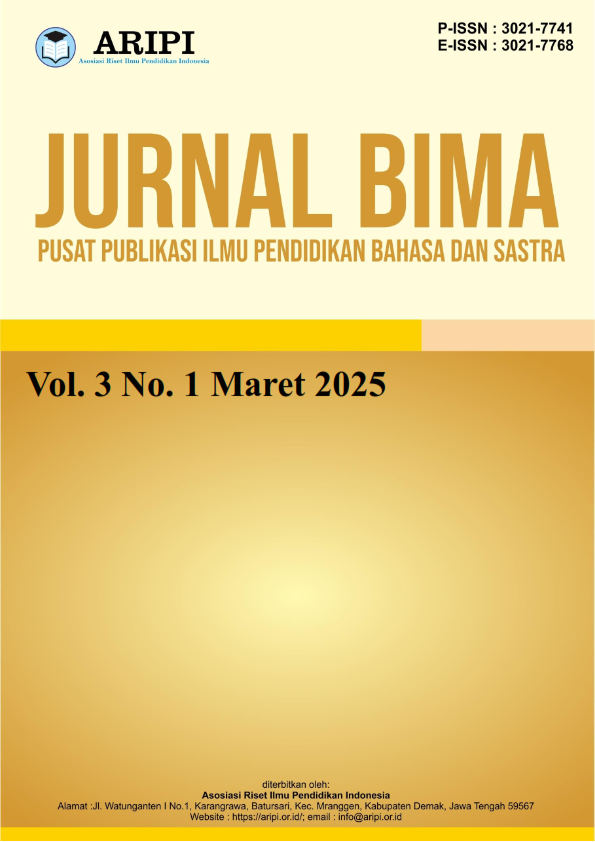Tindak Tutur Ilokusi dalam Cerpen Karma Tanah Karya Ketut Syahruwardi Abbas
DOI:
https://doi.org/10.61132/bima.v3i1.1559Keywords:
Speech acts, illocutionary, short story Karma TanahAbstract
This study examines illocutionary speech acts according to Austin's theory in the short story Karma Tanah by Ketut Syahruwardi Abbas. This study aims to describe the form of illocutionary speech acts in the short story Karma Tanah by Ketut Syahruwardi Abbas, to describe the contextual meaning in the short story Karma Tanah by Ketut Syahruwardi Abbas. This study uses a qualitative research type with a descriptive method. The research data used are dialogues in the form of words, phrases, clauses, and sentences that indicate illocutionary speech acts. The source of research data is the short story Karma Tanah by Ketut Syahruwardi Abbas. Data was obtained using the first technique, the researcher classified the data obtained during the reading stage, then grouped based on the form and meaning of the illocutionary speech found in the short story Karma Tanah by Ketut Syahruwardi Abbas. Furthermore, the researcher analyzed all groups of data based on the form and meaning of the illocutionary speech and finally the researcher made conclusions or described the data based on the results of the analysis. The results of this study were obtained with 17 speech data found divided into five types of illocutionary speech acts, namely assertive speech acts as many as 4 utterances, directive speech acts as many as 5 utterances, expressive speech acts as many as 3 utterances, commissive speech acts as many as 3 utterances, and declarative speech acts as many as 2 utterances. The meaning of the utterance is adjusted to the context of the utterance. From these results, the form of assertive and directive speech acts states that the most are found in the short story Karma Tanah.
Downloads
References
Chaer, A., & Agustina, L. (2004). Sosiolinguostik. Jakarta: Rineka Cipta.
Hairani, H., Innuddin, M., Rachman, D. F., Fathoni, A., & Hadi, S. (2023). Sosialisasi Internet Sehat, Cerdas, Kreatif Dan Produktif Pada Masyarakat Kalijaga Baru. Valid Jurnal Pengabdian, 1(3), 1-10.
Hidayah, T., & Dkk. (2020). Analisis Tindak Tutur Lokusi, ILokusi, dan Perlokusi Pada Film "Papa Maafin Risa". Jurnal Pendidikan Bahasa dan Sastra Indonesia, 3, 72.
Indrayanti, T. (2016). Penggunaan Tindak Lokusi dalam SMS Mahasiswa Fakultas Ekonomi Angkatan 2014 UNIPA Surabaya. Jurnal Buana Sastra, 1.
Moleong, L. J. (2016). Metodologi Penelitian Kualitatif. Bandung: PT. Remaja Rosdakarya
Nuroh, E. Z. (2011). Analisis stilistika dalam cerpen. PEDAGOGIA: Jurnal Pendidikan, 1(1), 21-34.
Rahardi, dkk. (2009). Pragmatik Fenomena Ketidaksantunan Berbahasa. Jakarta: Erlangga.
Rohmadi, M. (2004). Pragmatik Teori dan Analisis. Yogyakarta: Lingkar
Saidah, L., & Utami, S. (2024). Tindak Tutur Ilokusi pada Cerpen Arti Persahabatan Karya Tafassahu. Hortatori: Jurnal Pendidikan Bahasa dan Sastra Indonesia, 8(1).
Sekarsany, & Dkk. (2020). Tindak Tutur Ilokusi pada Proses Kelahiran dengan Teknik Hipnosis (Hype Nobirthing): Suatu Kajian Pragmatik. Metahumaniora, 1, 14-26.
Suhartono. (2020). Pragmatik Konteks Indonesia. Gresik: Graniti.
Yanti, L. R., Antosa, Z., & Adiputra, M. J. (2020). Analisis Kesulitan Guru Dalam Menerapkan Pembelajaran Dengan Pendekatan Saintifik. Primary: Jurnal Pendidikan Guru Sekolah Dasar, 9(1), 72-80.
Yule, G. (2006). Pragmatik. Yogyakarta: Pustaka Pelajar.
Downloads
Published
How to Cite
Issue
Section
License
Copyright (c) 2025 Jurnal Bima : Pusat Publikasi Ilmu Pendidikan bahasa dan Sastra

This work is licensed under a Creative Commons Attribution-ShareAlike 4.0 International License.






